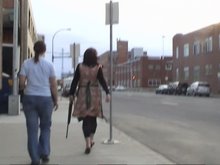Sunday, May 20, 2007
Jackson 2bears, Iron Tomahawks
Iron Tomahawks, Video and VJ performance Jackson 2bears
It is serendipitous that Jackson 2bears VJ’ed and brought the club context to Harcourt House hours before we found ourselves reversing the context, by bringing art to a club and dancing to DJ’ed music later on at night in Joshua Schwebels shoes. ( See Part 1 Morning discussion). The presence of VJ performances, most often experienced in club settings, is becoming increasingly more visible in performance art festivals.
Last night The Iron Tomahawks By Jackson 2bears was presented at Harcourt House in partnership with Latitude 53 and Visualeyez. This live performance utilizes digital encoded vinyl and software developed by the artist to mash-up and remix found film and video images of Native stereotypes ( Ie. White male actors dressing up like “Indians” from Hollywood films and also anthropological studies of Native dress and dance). Jackson 2bears remixes and reappropriates media images depicting Native stereotypes as a both a critical intervention into and “ a self-reflexive path of engagement with his native heritage”. (Noted in the festival program).
During the performance the audience sits on chairs on the edge of the exhibition space. Club lights strobe through the room, and a large screen displayed the mixed video. Jackson stands behind a table and a set of turntables, mixing throughout the performance. Some audience members comment on how it is staged like a high school dance or local gymnasium performance. Irene Loughlin notes that it reminds her of inner city gymnasium or community performance venues. Interestingly, no one dances, even though there is a large empty floor in the centre of the room. In the context of the Harcourt House, the event functions as a form of storytelling or a video presentation consisting of a 28 minute VJ mash-up remix of archival film and video material.
Technically speaking, the integration of video image and rhythmic beats is well crafted and performed live the use of the digital-encoded vinyl and custom made software give the mix a quick and smooth correlation between audio and image. See a short clip from the performance above.
One of the criticisms that often surfaces around the performance of DJ/VJ mixing is that the convention of display and staging is rarely critically considered. Performance art audiences have come to expect a conceptual engagement with the audience/performer relationship. Given the context of the festival, one that is very much about site-specificity and audience-performer relations, the site where the mixing occurs also becomes integral to the performance. In this case, the audience is left unsure of how to engage with the work. Do we dance, as if we are in a club? The chairs set up in the room, suggest to the audience that it is expected that we sit and watch. If I had been at a club, I would have been inclined to dance—but as it was, I would have been the only one on the room and then I would be implicated as a “planted” performer-so I didn’t.
Perhaps it is the nature of the introduction to the event that added an air of austerity and sobriety to the context. The directors of the galleries made a point of thanking all the funders, the city counselor (who was in the audience), noting how important it is to prevent racism against Native and First Nations People. While this is certainly necessary, the focus on first nations representation as a highlight of the festival was extensive and disproportionate to the full scope of the artistic expression of Jackson 2bears performance. This may have more to do with the site specificity of the Harcourt House as a venue that relies on government funding that requires specified allocation of funds towards diversity initiatives. While it is necessary to insure that moneys are allocated to artists traditionally underrepresented in the arts, the need to insist that this be the main point of focus rather than the work and ideas brought forth by the artist is disconcerting. It is for this reason that the context and site of the performance was perhaps more somber than what might have been intended within the delivery of the performance.
Jackson 2bears seeks to re-appropriate stereotypical images by decoding and recoding them. He changes the visual syntax and the stereotypes are reordered through repetition. Deleuze makes the case for difference in repetition, where movements that are reappropriated bring with them a shift or drifting. Others disagree with this, like Tanya Lukin-Linklater one of the artists who performed the first night, who commented to me that the tactic of appropriation does not change the stereotypical representation of First Nations People. Some images—like those of the Pow Wow are sacred, she notes. I wonder at the site of performance in relation to the images and sound---how might the frame of presentation be recoded and shifted to confront the desires and promixity of funders, audience and performer? How might this engage a politic of (re)appropriation that both challenges stereotypes and entices audiences to share in divesting images of racist inflections?
Subscribe to:
Post Comments (Atom)



No comments:
Post a Comment